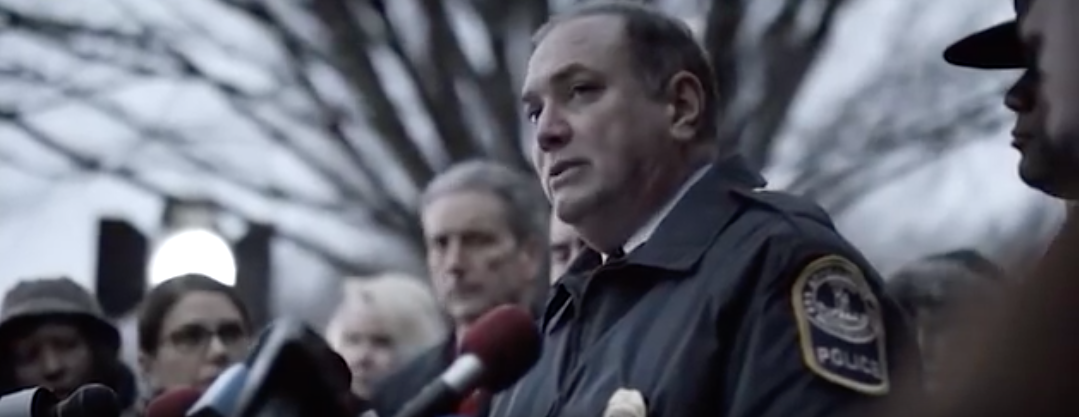FBI Film Underscores Importance of Media Relations

The FBI in 2015 made a 25-minute training film depicting an active-shooter crisis at a fictional Virginia university. While the focus is on operational response, one of the film’s themes is that to forgo media relations for allegedly more pressing matters is to make a terrible mistake.
The sooner you talk to the press, the sooner you’ll stem the panic.
–Agent Mary Lavelle, The Coming Storm
The Coming Storm’s protagonist is Appomattox University Chief of Police Carl Stann, who commands the operation. Stann’s contempt for the press is clear. When FBI Agent Mary Lavelle tells him the feds can provide extra media people to help with the press, Stann says, “That is not my priority.” Lavelle responds, “The sooner you talk to the press, the sooner you’ll stem the panic.”
That’s an important crisis lesson.
Later, during a meeting on the unfolding tragedy, Stann asks about the press-conference plan. The ensuing back-and-forth supplies a nice fly-on-the-wall feel of what a crisis can be like.
“Carl, you should be the face of this thing,” Ron Czarnecki, the FBI’s local special agent in charge, says to Stann. “This is your campus, your crime scene.”
“I hate talking to the press,” Stann complains.
“You only have to make a short statement now,” says FBI Agent Lavelle, who tells her boss two other agents are already working on talking points and setting up the press area.
“She’s been doing this for 10 years,” Czarnecki tells Stann. “She can walk you through the plan. It’ll take 15 minutes.”
Stann finally agrees to it, and the film closes with his press conference (pictured). His remarks are a good example of what should be said in an initial communication. Stann provides information the public is hungering for and expresses sympathy for the victims.
Law-Enforcement Leaders
He first introduces himself and the law-enforcement leaders standing behind him. He lays out the basic facts of the incident, including how many people were killed and injured and what hospital the injured were taken to.
“I can confirm that two police officers responded to the sound of gunfire within minutes, and engaged the shooter, killing him,” he says. “These officers saved countless lives today.”
The name of the shooter (a former student at the school) will be released once his family has been notified of his death, Stann tells the press. He notes that a toll-free number has been established for families to get information.
“This is an active investigation and I will provide you with information as soon as I can,” Stann says and notes that his comments will be posted on the university’s website and social media. He says he’ll return in 90 minutes to provide an update (in a crisis, it’s important to let people know that the communication will continue).
Stann begins to choke up and says, “Our deepest sympathies go out to the families and loved ones who are dealing with this tragedy. Our entire community mourns this senseless loss of life. Thank you.”
He takes no questions despite reporters shouting them at him.
Misinformation Problem
During the presser, Stann also dealt with the difficult problem of misinformation. He noted there were rumors of a second shooter, but said no evidence supported those rumors. Although mass shootings are usually committed by a lone perpetrator, victims often think more are involved because they see plain-clothes police arrive early on with guns and mistake them for the bad guys.
After the film, the FBI shows excerpts of interviews with real-life law-enforcement officials who were involved in high-profile active-shooter crises, including at Sandy Hook Elementary School in Newtown, Connecticut, in 2012; a movie theater in Aurora, Colorado, in 2012; and the Washington Navy Yard in D.C. in 2013 (where early mistaken reports about multiple shooters were a big problem).
Here, too, the importance of media relations is not ignored. One point made is that the media tsunami is inevitable. Another is to not let the story be driven by rumors — that’s why Chief Stann had to get out there and talk to the press.
Chief Patrick Gannon of Los Angeles World Airports worked the 2013 incident at Los Angeles International Airport in which a man shot and killed a Transportation Security Administration officer and injured several others.
“If I had to do it all over again, I would give a press conference within the first 45 minutes of the incident,” Gannon said. “We clearly had an understanding of what happened by then.”
Photo Credit: FBI
This is an abridged version of an article that appeared today on the CrisisResponsePro paid subscription portal. (CrisisResponsePro subscribers can access the full version by clicking here. ID and password are required.) To take advantage of all of the content, data, and collaborative resources CrisisResponsePro has to offer, contact us at info@crisisresponsepro.com.




 Back to Blog
Back to Blog